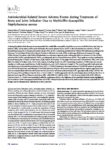Antimicrobial-related Severe Adverse Events During Treatment of Bone and Joint Infection Due to Methicillin-Susceptible Staphylococcus Aureus
Prolonged antimicrobial therapy is recommended for methicillin-susceptible Staphylococcus aureus (MSSA) bone and joint infections (BJI), but its safety profile and risk factors for severe adverse events (SAE) in clinical practice are unknown. We addressed these issues in a retrospective cohort study (2001 to 2011) analyzing antimicrobial-related SAE (defined according to the Common Terminology Criteria for Adverse Events) in 200 patients (male, 62%; median age, 60.8 years [interquartile range {IQR}, 45.5 to 74.2 years]) with MSSA BJI admitted to a reference regional center with acute (66%) or chronic arthritis (7.5%), osteomyelitis (9.5%), spondylodiscitis (16%), or orthopedic device-related infections (67%). These patients received antistaphylococcal therapy for a median of 26.6 weeks (IQR, 16.8 to 37.8 weeks). Thirty-eight SAE occurred in 30 patients (15%), with a median time delay of 34 days (IQR, 14.75 to 60.5 days), including 10 patients with hematologic reactions, 9 with cutaneomucosal reactions, 6 with acute renal injuries, 4 with hypokalemia, and 4 with cholestatic hepatitis. The most frequently implicated antimicrobials were antistaphylococcal penicillins (ASP) (13 SAE/145 patients), fluoroquinolones (12 SAE/187 patients), glycopeptides (9 SAE/101 patients), and rifampin (7 SAE/107 patients). Kaplan-Meier curves and stepwise binary logistic regression analyses were used to determine the risk factors for the occurrence of antimicrobial-related SAE. Age (odds ratio [OR], 1.479 for 10-year increase; 95% confidence interval [CI], 1.116 to 1.960; P = 0.006) appeared to be the only independent risk factor for SAE. In patients receiving ASP or rifampin, daily dose (OR, 1.028; 95% CI, 1.006 to 1.051; P = 0.014) and obesity (OR, 8.991; 95% CI, 1.453 to 55.627; P = 0.018) were associated with the occurrence of SAE. The high rate of SAE and their determinants highlighted the importance of the management and follow-up of BJI, with particular attention to be paid to older persons, especially for ASP dosage, and to rifampin dose adjustment in obese patients.



